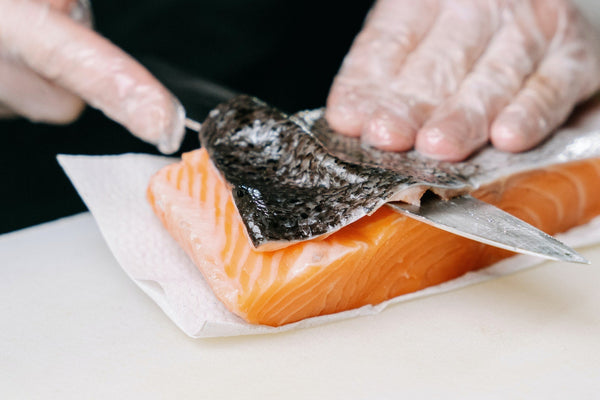How to Remove Salmon Skin Before Cooking
Updated on May 24, 2023
Some recipes call for removing the skin from salmon before cooking, whether for texture preferences or to allow marinades and seasonings to penetrate more effectively.
While deskinning salmon might seem intimidating at first, learning the right technique helps avoid wasting the valuable meat. Here, we'll guide you through a step-by-step approach on how to remove skin from salmon like a pro, so that your dish turns out just right!
What You’ll Need to Remove Salmon Skin
Before diving into the process of removing salmon skin before cooking, gather the right tools. Having everything ready will make the task smoother and more efficient. Here’s a list of what you’ll need:
- Knife. A sharp, flexible knife makes clean cuts between the skin and the flesh. The MANNKITCHEN MK9 Chef Knife, opens in a new tab is ideal for removing salmon skin, featuring a blade made from X63-Nitrogen Steel for surgical sharpness and excellent edge retention. Its design ensures stability and hand protection.
- Cutting board. A sturdy, non-slip cutting board provides a safe surface to work on. Consider materials such as bamboo, hardwood, or plastic, as they offer durability and ease of maintenance.
- Paper towels or cloth. These are useful for cleaning your workspace and drying the fish if needed.
- Fish tweezers. These can help remove any small pin bones that may be left in the fillet. Choose tweezers made from stainless steel for durability and corrosion resistance, especially when working with fish.
How to Remove Salmon Skin Before Cooking
Follow these step-by-step instructions for a smooth process of skinning salmon that results in a perfectly prepared piece of fish ready for your favorite recipes!
Step #1: Prepare your workspace
First, get your workspace ready by placing a cutting board on a flat, stable surface. Make sure the area is clean to prevent any germs and to help you work better.
Step #2: Position the knife
Next, lay the salmon fillet skin-side down on the cutting board. Start at the tail end of the fillet and slide the knife between the skin and the flesh about an inch from the edge. This will make the process easier and more manageable.
Step #3: Angle the knife
As you start cutting, hold the knife at a slight angle down toward the skin. This helps you cut cleanly without slicing into the flesh, which keeps more of the salmon meat intact.
Step #4: Begin cutting
Gently press down on the knife while pulling the skin away from the flesh with your other hand. Use a smooth, back-and-forth motion, keeping the knife at the same angle. This helps avoid tearing the skin or the meat.
Step #5: Continue along the salmon fillet
Keep moving your hand along the skin as you cut, using tension to guide the knife smoothly along the fillet. This tension helps you make a clean cut and prevents wasting any fish. Once you reach the other end of the fillet, look for any leftover skin or bits that need trimming. If you see any small pieces, use the knife to cut them off so the fillet looks neat.
Step #6: Clean up
Finally, clean your workspace by wiping the cutting board and knife with paper towels to remove any fish residue. Check the fillet for pin bones and use fish tweezers to pull them out if needed. This provides for a better eating experience.
Frequently Asked Questions
Let's address some common questions about salmon skin in terms of its safety, necessity, and tips for minimizing waste while removing it.
Is it safe to eat salmon skin?
Yes, it is safe to eat salmon skin as long as the fish is fresh and properly prepared. Salmon skin is nutritious and can be delicious when cooked, often becoming crispy and adding flavor to dishes. Just make sure to wash the skin well before cooking to remove any scales or contaminants.
Is it necessary to remove the skin from salmon?
Some people like the skin because it can add flavor and help keep the fish moist when cooking. Whether to remove it or not is a matter of personal preference, so you can cook it with the skin on or take it off based on what you enjoy.
How do I avoid wasting meat when removing the skin?
To avoid wasting meat when removing the skin from salmon, use a sharp knife and keep it angled down toward the skin. Pull the skin tight with one hand while gently sliding the knife along the skin with the other hand. This helps you make clean cuts without taking too much of the fish meat with it. Taking your time and being careful will help you get the most meat from the fillet.
Summary
Getting skin off salmon doesn't have to be a daunting task. With the right tools and techniques, you can efficiently remove the skin while preserving the meat for your favorite dishes.
Remember to take your time, maintain a steady hand, and follow the steps outlined above for the best results!








